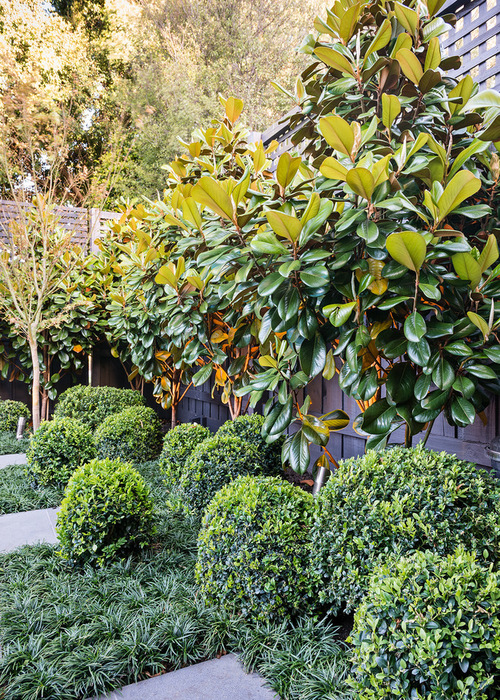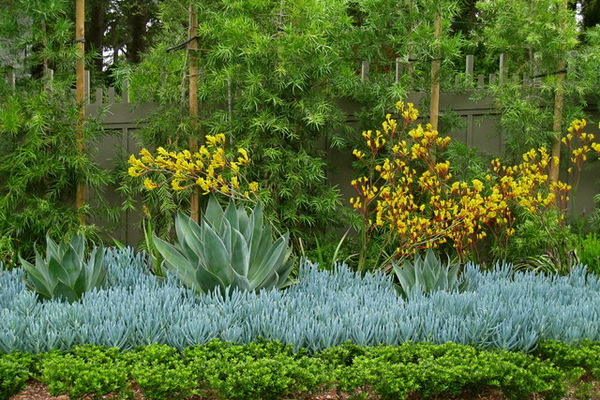 Houzz
Houzz Backyard Pool Design by Anston Architectural
Author: Josh Harrison
People’s taste in the architectural aesthetic of houses has changed over the last 10 years, and so have the plants that accompany these homes. Plants need not only suit the style of the home, they need to complement it too, and that’s especially important for privacy and screening plants that often form the backdrop of the garden.
As my clients have become more design-savvy, so have their requests for more imaginative solutions when using plants to create privacy and screening. Screening plants are not only just about privacy from neighbours though – they also serve as a windbreak, protection from the sun, or are simply a way to block an unsightly aspect. Below are my top tips for creating screening and privacy for your contemporary home.
Browse popular garden designs on Houzz
The tall and skinny variety
The process of ‘pleaching’ trees (removing the foliage from the lower stem) has been done for hundreds of years, however, in recent years, many landscapers have began to pleach the stems of Bamboo. Pleaching the stems creates a negative space below the foliage that can either be left bare or under-planted with a creeper or low shrub.
Bamboo is an excellent privacy solution for the modern home as it grows up to 6m high without the width that comes from most privacy plants, making it perfect for smaller block sizes.
While the old running bamboo received a bad reputation for creeping and spreading into neighbouring properties, the new cultivars such as slender weavers (Bambusa textilis‘Gracilis’) are what’s called ‘clumping’ bamboos. Clumping bamboos don’t spread like the old style and will only clump and thicken up directly around the base of the plant.
Shop a wide selection of outdoor furniture online
The low-maintenance variety
Spineless or soft-tipped yucca (Yucca elephantipes) has long been a favourite for sunny, windy positions. The architectural foliage and structure of the plant makes it a perfect screening option for the modern home.
Yuccas require very little water and can handle plenty of neglect. They may not provide the thickest of privacy solutions, however, when planted together, Yuccas form an excellent windbreak and protection from the sun.
Pleaching the stems is a great way to accentuate the architectural form of the plant. It also gives you the opportunity to under-plant with a colourful creeping plant.
Read more: Take the Headache Out of Gardening With Low-Care Landscaping
The floral variety
The Magnolia grandiflora ‘Little Gem’ has been a popular plant over the last 10 years as both a feature tree and a screening plant. A new cultivar calledMagnolia grandiflora ‘Teddy Bear‘ is also currently taking the market by storm.
The ‘Teddy Bear’ features the same two-toned leaves and the iconic large white flowers. The big difference is the way the ‘Teddy Bear’ tends to form a tighter more dense foliage, making it a great option for screening and privacy.
Unlike the other plants listed above, the ‘Teddy Bear’ is great in instances where you want to bring a splash of colour to your garden. The large white flowers are stunning when in bloom and make the perfect perimeter border.
The resilient variety
Most people are familiar with the old favourite mother in-law’s tongue (Sansevieria trifasciata), an old-school plant that has made a comeback in recent years.Sansevieria stuckyi is a new cultivar and features longer, thicker stems that grow to around 120cm long.
This striking plant works just as well in pots as it does in the ground, and will happily handle the harsh conditions near the coast or up on balconies and rooftops. It’s also extremely drought tolerant.
While it doesn’t provide the thickest of screens, it works well when you still want to let a bit of dappled light through.
The fruity variety
Podocarpus elatus, a native to the east coast of Australia, which is commonly known as the bush plum, has started to create a following amongst landscapers as a privacy solution for the modern home.
When grown on their own, bush plum can reach nearly 30m high as a tree, however, when planted in rows at 15cm centres, they form the perfect hedge for privacy and can be kept to a height of 150cm if required.
The great thing about bush plum is that they don’t get too wide, which makes them great for small blocks where every bit of space needs to be utilised.
The textured foliage, which resembles fingers, creates an interesting focal point and the perfect backdrop to a garden.




